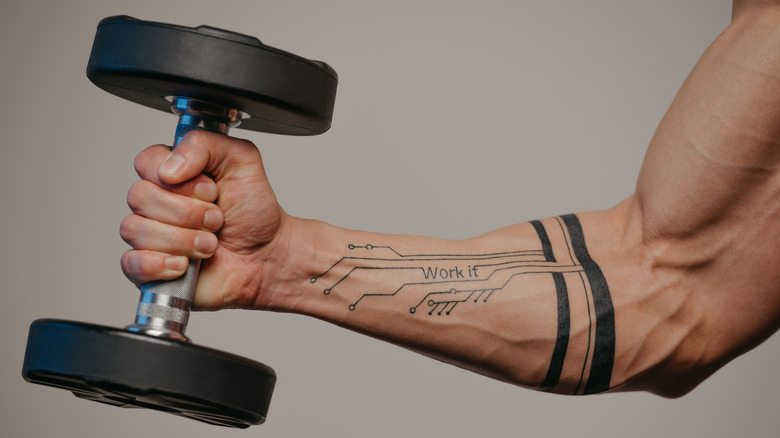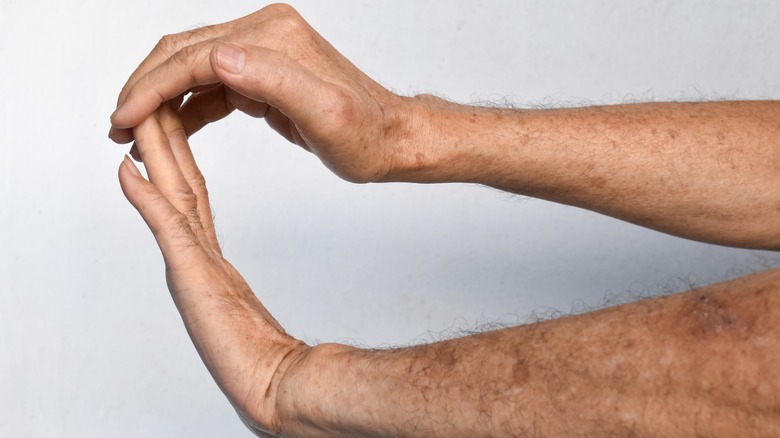Exercise To Help Stretch And Relieve Forearm Pain
Whether you spend most of your day typing away at a desk, crafting cocktails, or working outside with your hands, your forearms are sure to be putting in work. Our forearms, located between the elbow and wrist, are comprised of the radius and ulna bones, as well as two muscular compartments that, together, are home to 20 muscles that are essential to the fine motor actions of the arm, wrist, and fingers, as per a StatPearls article.
We count on the proper functioning of our forearms for everything from opening jars and carrying groceries to sports-related activities, like golf and basketball, according to the National Federation of Professional Trainers.Therefore, because we rely so heavily on our forearms to help us carry out everyday activities, forearm pain can have a tangible impact on our daily lives.
With that being said, let's take a look at the different reasons you may be experiencing forearm pain, and what you can do to improve it so you can get back to business as usual.
Causes of forearm pain
When it comes to forearm pain, the experts at Healthline list a wide range of potential causes. It's possible that your forearm pain can come from arthritis, for one, a condition in which the cartilage inside your joints that is meant to keep your bones from rubbing together becomes worn down. Carpal tunnel syndrome is another common culprit of forearm pain. Carpal tunnel, which MedlinePlus says affects between 1% and 5% of the population, occurs when the nerve canal that leads from the wrist to the fingers becomes constricted, resulting in the painful compression of the nerves.
In addition, pain can also be brought on by a fall that causes bone, muscle, or ligament damage, as well as muscle strain, overuse injuries, and nerve damage caused by poor posture or conditions, like diabetes or thyroid disorders (via Healthline).
Therefore, when the pain stems from overuse, tendon damage, or nerve constriction, at-home remedies, like rest, anti-inflammatory medication, immobilization in the form of a sling or brace, and hot and cold therapy, can be effective, explains Medical News Today.
Exercises for forearm pain
If your forearm pain is treatable at home, Medical News Today suggests that exercises for stretching and strengthening the forearms can also be beneficial. One way you can stretch your forearms is by performing wrist extensions. To do so, stand up with your injured arm stretched out in front of you, keeping your palm parallel to the floor. With your opposite hand, gently grip the fingers and pull the wrist back until your palm is parallel to the opposite wall. Make sure you feel a stretch in your forearm without any pain and hold the position for 20 seconds.
Next, do some wrist rotations to increase blood flow. Extend both arms in front of you so they're at level with your shoulders. Make both hands into fists and roll the wrists clockwise 10 times. Then repeat the same motion another 10 times in a counterclockwise motion.
When looking to increase flexibility and reduce forearm pain, elbow extensions can be invaluable. To perform elbow extensions, find a comfortable seat where you can place your elbow on a table or the arm of a chair with the forearm hanging off. Then, use your opposite hand to press the forearm toward the floor. Again, you're looking to feel a stretch without any pain or pinching. For the best stretch, hold the position for 15 seconds. But before putting these exercises into practice, check with your doctor to be sure they aren't going to make your condition worse.



